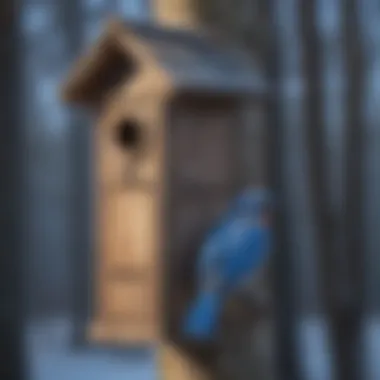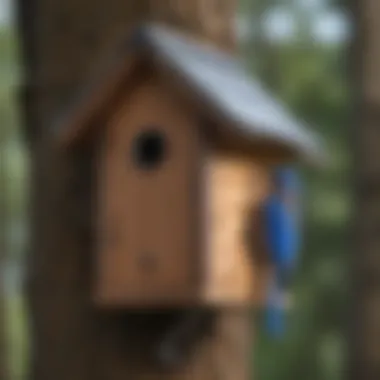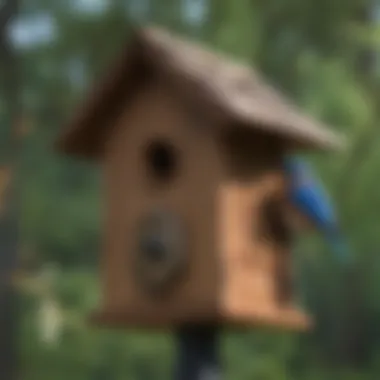Expert Guide on Setting Up a Bluebird House for Your Garden


Overview of Setting Up a Bluebird House
Setting up a bluebird house is a meticulous process that requires careful consideration and attention to detail. Bluebirds are beautiful creatures that can bring joy to any garden or backyard. By creating a welcoming environment for them, you increase the chances of attracting these delightful birds to nest in your bluebird house. This comprehensive guide will walk you through the essential steps to ensure the successful establishment of a bluebird house in your outdoor space.
Selecting the Perfect Location
Selecting the right location for your bluebird house is crucial to its success. Bluebirds prefer open areas with low vegetation and easy access to food sources. Choosing a spot with adequate sunlight, away from predators, and at least 5 feet above the ground will help create an ideal habitat for bluebirds. Additionally, ensuring that the area is quiet and undisturbed will further enhance the chances of attracting bluebirds to your garden.
Ensuring Proper Installation
Proper installation of the bluebird house is essential for the safety and comfort of the birds. Mounting the house on a metal pole with a predator guard can prevent unwanted guests from harming the bluebirds or their eggs. Positioning the entrance hole facing away from prevailing winds and providing proper ventilation inside the house are also crucial considerations during installation. By following these steps, you can create a secure and inviting space for bluebirds to build their nest.
Monitoring and Maintenance
Once the bluebird house is set up, regular monitoring and maintenance are necessary to ensure its continued usability. Checking the house for damage, cleaning out old nests after each brood, and making any needed repairs are essential tasks for maintaining a healthy environment for bluebirds. By being proactive in your monitoring efforts, you can help create a sustainable habitat for bluebirds and enjoy their presence in your garden for years to come.
Conclusion
Introduction
As we embark on this endeavor, it becomes imperative to underscore that the importance of the bluebird house transcends mere aesthetics or ornithological intrigue. Within the stout wooden confines of this bespoke abode lies a sanctuary for a species in need, a beacon of hope for the continuation of a life cycle intertwined with the very fabric of our terrestrial tapestry. The bluebird is not merely a proverbial 'bluebird of happiness,' but an emissary of ecological balance and ornithological grace, reminding us of our intrinsic role as custodians of the natural world.
This introductory stage sets the tone for a meticulous exploration into the nuances of bluebird behavior, habitat preferences, and the symbiotic relationship between humans and these ethereal creatures. By delving into the realm of bluebird species identification and behavioral intricacies, we unravel the enigmatic charm that surrounds these dwellers of the open sky. Through an introspective journey into the nesting habits of bluebirds, we gain insight into their proclivities and requirements, guiding us towards optimal practices in bluebird house placement and maintenance.
Understanding Bluebirds
Identifying Bluebird Species
When engaging in the venture of setting up a bluebird house, being able to identify different bluebird species is a crucial skill. The most common species—the Eastern Bluebird, Western Bluebird, and Mountain Bluebird—each have distinct characteristics that set them apart. Recognizing these subtle variations contributes to effectively catering to the unique needs and behaviors of each species. With this knowledge, individuals can tailor their bluebird house setup to attract the specific bluebird species prevalent in their region, enhancing the chances of successful nesting and habitation.


Behavior and Nesting Habits
Exploring the behavioral patterns and nesting tendencies of bluebirds is integral to fostering a hospitable environment for these birds. Bluebirds exhibit specific behaviors such as foraging habits, territoriality, and courtship rituals that play a significant role in their nesting process. Understanding these behaviors enables individuals to create a habitat that not only entices bluebirds but also supports their natural instincts for breeding and raising young. Insights into bluebird nesting habits, such as their preference for open habitats with nearby perches, aid in optimizing the bluebird house location and design to align with these requirements, fostering a conducive environment for successful bluebird populations.
Selecting the Right Bluebird House
In the intricate process of creating a hospitable environment for bluebirds in your garden or backyard, selecting the appropriate bluebird house plays a pivotal role. This section delves into the importance of choosing the right bluebird house, shedding light on specific elements, benefits, and considerations crucial for the well-being and attraction of these beautiful birds.
When considering the ideal bluebird house, several key factors come into play. The design, dimensions, and materials utilized are paramount in ensuring a comfortable and safe nesting space for bluebirds. Each element contributes to the overall appeal and functionality of the house, directly impacting the likelihood of bluebirds taking up residence.
Choosing the Appropriate Design
The design of a bluebird house is not merely aesthetic; it plays a fundamental role in attracting bluebirds and providing them with a suitable shelter. Opting for a design that mimics natural bluebird habitats can significantly increase the chances of these birds choosing your house for nesting. Features such as appropriate entry hole size, predator guards, and proper ventilation are essential considerations in the design phase.
When selecting a design, prioritize simplicity and functionality. Bluebirds prefer uncomplicated layouts that mimic their natural nesting sites. A well-thought-out design that incorporates elements like sloped roofs to deter predators and proper drainage to maintain nest dryness will be more appealing to bluebirds seeking a safe haven.
Optimal Dimensions and Materials
Achieving the right balance in dimensions and materials is imperative when setting up a bluebird house. The size of the house must accommodate the species' requirements, with appropriate dimensions ensuring a snug fit without feeling cramped. Bluebirds are meticulous in their selection of nesting sites, making it essential to provide a house that meets their spatial needs.
When it comes to materials, durability and insulation are key considerations. Opt for weather-resistant materials that offer protection against the elements while providing adequate insulation for the inhabitants. Wood such as cedar is a popular choice due to its durability and natural resistance to decay, offering a safe and comfortable environment for bluebirds.
Preparing the Installation Site
As a crucial step in the process of setting up a bluebird house, preparing the installation site is paramount to the success of attracting bluebirds. The site preparation directly impacts the safety, comfort, and nesting success of these beautiful birds. When considering the installation site, several elements come into play, each playing a vital role in creating an optimal environment for bluebirds to thrive.
First and foremost, selecting the right location for the bluebird house is essential. Bluebirds prefer open areas with easy access to fly in and out of the house. Ensuring that the house is placed away from busy pathways or areas with high human activity is crucial to prevent disturbance and increase the chances of bluebirds nesting. Additionally, having nearby perching spots for bluebirds can further enhance the attractiveness of the installation site.
Furthermore, providing adequate protection from predators is a key aspect of preparing the installation site. Bluebirds are vulnerable to predators such as cats, snakes, and raccoons. To mitigate this risk, consider installing predator guards or baffles to prevent access to the bluebird house. Placing the house at a suitable height can also deter predators from reaching the nesting area.


In summary, preparing the installation site for a bluebird house involves careful consideration of the location and protection measures. By creating a safe and appealing environment, you can increase the likelihood of attracting bluebirds to nest in the house.
Ideal Location Criteria
Selecting the ideal location for a bluebird house is a key factor in successfully attracting bluebirds to nest. Bluebirds have specific preferences when it comes to their nesting sites, making it essential to meet certain criteria to make the location attractive to them.
Firstly, bluebirds prefer open spaces with a clear line of sight to spot potential predators. Placing the house in an open area, away from dense vegetation or clutter, provides bluebirds with a sense of security and visibility. Additionally, positioning the house facing towards a tree or shrub can offer perching spots for bluebirds to observe their surroundings.
Moreover, maintaining a suitable distance between bluebird houses is important to prevent territorial disputes between competing bluebird pairs. Placing houses at least 100 yards apart can help reduce conflicts and ensure a harmonious nesting environment for bluebirds.
Protection from Predators
Protecting bluebirds from predators is essential to ensure their safety and nesting success in a bluebird house. Predators pose a significant threat to bluebirds, especially during the nesting season, making it imperative to implement effective protection measures.
One of the primary methods of protecting bluebirds from predators is by installing predator guards or baffles. These devices create a physical barrier around the entrance of the bluebird house, preventing predators like snakes and raccoons from reaching the nest. Ensuring that the guards are secure and properly fitted is critical to their effectiveness.
Additionally, placing the bluebird house at an appropriate height can help deter ground-based predators. Mounting the house at least five feet above the ground can make it challenging for predators to access the nest. Regularly monitoring the area around the house for signs of predator activity is also important to address any potential threats promptly.
In summary, safeguarding bluebirds from predators through the use of predator guards, proper mounting heights, and vigilant monitoring can significantly increase their chances of successfully nesting in a bluebird house.
Installing the Bluebird House
Installing the bluebird house is a crucial step in creating a welcoming environment for these beautiful birds. Proper installation ensures the safety and comfort of the bluebirds, increasing the likelihood of them nesting in your backyard. When it comes to setting up the bluebird house, several specific elements need to be considered to maximize its effectiveness.
Mounting Height and Direction
The mounting height and direction play a key role in attracting bluebirds to your bluebird house. Bluebirds prefer houses that are mounted at the right height, typically between five to ten feet above the ground. This height provides them with a sense of security from predators while also offering them a good vantage point to survey their surroundings. When choosing the direction to face the entrance hole, it is essential to orient it towards the east or southeast. This positioning helps protect the bluebirds from prevailing winds and excessive sunlight during the hottest part of the day.
Proper Ventilation and Drainage


Proper ventilation and drainage are essential aspects to consider when installing a bluebird house. Adequate ventilation helps regulate the temperature inside the house, preventing overheating during the scorching summer months. To ensure good airflow, the bluebird house should have ventilation holes located near the top to allow hot air to escape. Additionally, proper drainage is crucial to prevent rainwater from seeping into the nest, which could endanger the hatchlings. Including drainage holes at the base of the house will help dispel any accumulated moisture, maintaining a dry and safe environment for the bluebirds.
Maintenance and Monitoring
Maintaining and monitoring a bluebird house are critical aspects that ensure the well-being of the bluebirds nesting within. Proper upkeep allows for a healthy and safe environment, contributing to the success of bluebird conservation efforts. Regular maintenance guarantees the longevity of the house, protecting it from wear and tear caused by weather conditions and potential predators.
Consistent cleaning of the bluebird house is imperative to prevent the spread of diseases and parasites that could harm the bluebirds. A structured cleaning schedule should be followed, involving the removal of old nesting materials, debris, and any signs of infestation. Cleaning should be done at the appropriate times of the year, such as after the nesting season, to prepare the house for new inhabitants.
Effective monitoring of bluebird activity provides valuable insights into their behavior and nesting habits. Careful observation allows for the identification of any issues that may arise, such as competing bird species or disturbances near the nesting site. Monitoring also aids in tracking the success of bluebird breeding, offering researchers and conservationists vital data for population studies and habitat management.
Cleaning Schedule
Establishing a regular cleaning schedule for the bluebird house is essential for ensuring a hygienic and safe living space for bluebirds. The cleaning frequency may vary depending on the nesting season and local environmental conditions. It is recommended to clean the house thoroughly after each brood has fledged to remove any remnants of the previous nesting cycle.
During cleaning, all old nesting materials, such as grass, feathers, and droppings, should be carefully removed to prevent the accumulation of bacteria and parasites. The interior surfaces of the house should be scrubbed with a mild cleaning solution and thoroughly rinsed to eliminate any harmful residue. Inspecting the house for signs of damage or wear is also crucial during the cleaning process, ensuring prompt repairs or replacements when necessary.
Proper storage of the bluebird house components, when not in use, is paramount to preserve their quality and integrity. Storing the house in a dry and sheltered location helps prevent deterioration and prolongs its lifespan, readying it for future use by bluebirds or other cavity-nesting birds.
Observing Bluebird Activity
Regularly observing bluebird activity near the house offers a direct glimpse into the lives of these captivating birds. By noting their daily routines, feeding patterns, and interactions, observers can deepen their understanding of bluebird behavior and lifestyles. Observations can reveal valuable information about nesting cycles, mate selection, and parental care, aiding in scientific research and conservation efforts.
Noting any disturbances or unusual behaviors can signal potential threats to the bluebirds' well-being. Intrusions by predators, human activities, or environmental stressors can disrupt the nesting process and endanger the bluebird family. Vigilant observation allows for timely intervention, whether through predator deterrents, habitat enhancements, or public awareness campaigns to safeguard the bluebird population.
Detailed documentation of bluebird activity through photographs, notes, or journals proves beneficial for long-term monitoring and analysis. Tracking changes in population dynamics, habitat usage, and behavioral adaptations contributes to the broader understanding of bluebird ecology and the effects of human interactions on their survival.
Landscaping for Bluebird Appeal
Creating an appealing landscape for bluebirds is essential in drawing these avian visitors to your garden or backyard. Bluebirds are known to favor open spaces with visible perches like fence lines or individual posts. Including native shrubs, bushes, and trees in your landscaping can provide bluebirds with shelter and potential nesting sites. Moreover, a variety of vegetation heights can offer bluebirds diverse foraging opportunities, catering to their natural behaviors. By designing your landscape to be bluebird-friendly, you can significantly increase the chances of attracting these delightful birds to your outdoor space.
Conclusion
In the realm of setting up a bluebird house, the conclusion plays a pivotal role in summarizing the intricate steps involved in this process. Understanding the significance of the conclusion is essential for enthusiasts looking to attract these stunning birds to their surroundings. An effective conclusion encapsulates the essence of the entire article, distilling key points and crucial considerations for fostering a bluebird-friendly environment. It serves as a crucial wrap-up, emphasizing the importance of meticulous planning and execution to ensure the success of the bluebird house endeavor.
The conclusion segment of this article serves as a beacon of guidance, shedding light on the meticulous details shared in the preceding sections. Offering a comprehensive overview, it reinforces the fundamental aspects discussed, enlightening readers on the critical nature of factors like location, installation, maintenance, and monitoring. By embracing the insights presented in the conclusion, individuals can cultivate an environment that is not only aesthetically pleasing but also conducive to bluebird habitation.
Furthermore, the conclusion acts as a compass for enthusiasts embarking on their bluebird house journey, outlining the benefits of following the recommended practices detailed in the article. From attracting bluebirds to fostering nesting opportunities, the conclusive remarks underscore the positive impact of adhering to best practices in bluebird house setup. By adhering to the guidelines elucidated in the conclusion, readers can maximize the probability of bluebirds gracing their gardens, offering a harmonious interplay between nature and human habitation.



